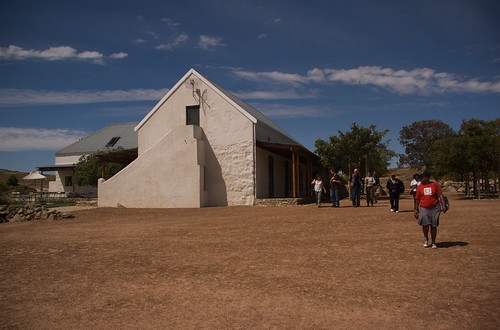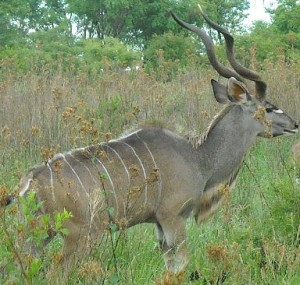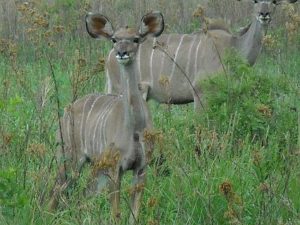Archive for 'Culture & Arts'
Following South Africa's Path

Our whirlwind bloggers’ tour of South Africa included a dizzying 22 stops during the first five days. We’ve seen so much — including the rich and diverse cultures of the native peoples, the technology that seeks to build a greener future, the urban centers, and the lush landscape — that it is easy to miss the forest for all these lovely trees.
Why — other than making for great travel entertainment — does South Africa matter so much to the world today and to our collective future?
During the tour we’ve seen how South Africans, including non-profits, community groups and the provincial and federal government, are working to protect the language, culture, and natural beauty of the nation. While much of the population still lives in the poverty of shanty towns, the government and private sector are getting better at sharing the new wealth from the diamond, gold, platinum and coal mining industries with the indigenous people.
Granted, this is a sponsored tour that attempts to show South Africa in the best possible light. But the interactions with people in the cross section of cities, towns and villages has revealed a strong commitment to making sure that future generations will have access to the nation’s rich heritage.
The !Khwa ttu center in Darling is preserving the spoken languages and tribal rituals of the San people to prevent them from being forgotten. The San people have been dispersed across all of Africa over the decades as more powerful groups have pushed them from their native lands. Parents of the current generation are no longer teaching the language, so the center is training children in their tribal culture and bringing together different San groups from all over Africa to share their common stories. The center also hopes to increase the financial resources for the local people by developing educational programs for tourists.
In the Richtersveld community on the west coast, money is flowing in after the resolution of a 10-year court battle over land rights and revenue from diamond mining after the land of the Nama people was taken away nearly a century ago. The local council of government is now determining how to spend the millions in back payments, with much yet to be decided about community and training programs.
The Richtersveld is also home to a 400,000 acre protected park of desert and mountains.  The park is also home to many priceless petroglyphs (stone carvings) dating back 10,000 years.
The park is also home to many priceless petroglyphs (stone carvings) dating back 10,000 years.
In many parts of South Africa, conservation programs are returning animals to their native habitats and invasive non-native species are being removed. I was overwhelmed by the majesty of many species of birds and mammals that are once again roaming the plain at the Plumari Game Reserve. Being able to connect with some of earth’s grandest species up close is a powerful reminder of how we need to act to prevent climate change from damaging their fragile habitats.
The Cradle of Humankind World Heritage Site contains the world’s richest deposit of hominid remains. Zuza Fakude, a native of Soweto, talked with me about the importance of researching and preserving our ancestors. Maintaining archaeological sites enhances our incomplete family tree, she says. “It is important to know where you’ve come from, because it gives another way to look at things. It offers another piece of the puzzle.” She said visiting Magaliesburg is “especially important for us black people, because we are very much people of our ancestors.”
Anthony Paton, Public Relations manager for the Gauteng provincial government, agrees that visiting the Cradle of Humankind drives home our common ancestor. “We are far closer together as a race than our superficial differences lead us to believe. That unity of people is symbolized in th[is] place… That we all started from a single source reinforces that we should consider our impact on the planet and each other as we move forward in what is expected to be a resource constrained and environmentally challenged world. If we have an awareness that we are all one, then we can avoid the tragedy of the commons” (in which farmers allow their animals to overgraze because of a desire for personal profit, even if it imperils the entire community).
A sustainable future requires a “communal effort in not putting in an extra cow. The challenge for now is to not add to the burden on the commons, or the planet.” However, Paton concedes that there is not an equality in interest in understanding our common ancestry. He says that his area’s historic and cultural centers are having difficulty attracting wealthy South African whites. “Many are arrogant and don’t want to be educated when they are on holiday. Conversely black Africans who can least afford to come to the area are the most interested in visiting.”
In Soweto, museums highlight the recent history of the struggles against and victory over apartheid, the system of government that suppressed the rights of black South Africans until 1994. The Hector Pieterson Museum is named for a 13-year old boy killed by police during a demonstration on July 16, 1976. The incident sparked outrage inside South Africa and around the globe and paved the way for the collapse of apartheid.
At the nearby Mandela Family Museum (which we sadly were not able to visit), the life of the former prisoner of apartheid and later South African president is detailed. Fakude says “the apartheid museum teaches us about what the worst people can do, but also about the best of what they can do. That shows us the possibilities of what we can still accomplish; that we can do so much more.”
While humanity has shown a sickening ability to abuse portions of the population, the victory of apartheid and coming together of the races in building a better South Africa is a lesson for all strife-torn regions. “We have gone through all of this rubbish and put it aside — not behind us, but aside. It shows what you can do for the future from your strength. It is important to have these things to hold on to.”
Going back to where it started — where the earliest land masses formed, where the oldest mountains reside, and where our common ancestor once foraged — drives home the need for a future that can sustain our entire global family. “We have to realize that we all have common problems regarding the environment, regarding carbon (emissions) … and the over-fishing of the seas,” says Paton. “These all stem back to a common thing — there are too many of us in our family (to consume and emit greenhouse gases like westerners). The only way we’ll have a long-term future is to realize that we’re part of the same family.”
iPod South Africa Style
iPod South African Style. This guy passed me in the Soweto Mall yesterday. How could I pass this up?
High on SA
 Nadine Khan of Brand South Africa came with us on the bloggers’ tour. Here’s what it has meant to her:
Nadine Khan of Brand South Africa came with us on the bloggers’ tour. Here’s what it has meant to her:
I woke up today a privileged South African. I have spent the last six days in the presence of some of the top US and local bloggers.
Together we have been exploring this beautiful country in almost every possible way imaginable. We have driven there by car, bus and 4 x 4. We have flown there by 707 Boeing, charter and helicopter and we even braved the stormy seas by ship.
All in an attempt to showcase the South African firsts, which are inventions or technology that South Africa is the first to use in the world. Our destinations have been broad and vast and the hours spend on the road has been long and ardours. We have seen it all. From launching satellites in space to bushmen rock paintings. From a helicopter scenic flight over the Cape Peninsula to going down the worlds deepest mine, we have done it.
Of course I came prepared. We had spend hours debating the programme of our tour to ensure that the best of the best is showcased as is, no gimmicks no false PR just the truth about what South Africa has to offer.
Or so I thought.
You see for the last six days I have had this nagging feeling of white guilt that just refuses to go away. Nothing on earth could have prepared me for this emotional awakening which I am experiencing.
Now for those of you that are familiar with our apartheid history will sigh and lament with me about our atrocious deeds committed by us to the less fortunate. But let me correct you the white guilt that I am currently suffering, is a fate far worse.
You see I have spend the last fifteen years apologising and lamenting the past and up until this trip would have probably had spend the next fifteen years in much the same frame of mind.
I would willingly have been part of a lost generation. Part of the generation of people who did not really cause apartheid nor fought the cause to end it.
So what happened you ask?
I was humbled by the sheer magnitude of passion of ordinary South Africans. I was touched and inspired by the everyday ordinary heroes of this enigmatic country.
At !Kwa Thu I met a San bushman, who despite the fact that there are only four people left in the world today that can still speak his language chooses to speak Afrikaans because it is the language his mother taught him.
In Alexander Bay I met a man and his wife who gave up the rat race and returned home to travel 400 kms per day in the arid dessert to promote the rock paintings and nomadic lifestyle of the bushman in an attempt to give back and preserve the Koi and San communities.
In Stellenbosch and in the Magaliesberg I met coloured people who are so proud of their French and Dutch colonial heritage that they wear it with pride.
In Melrose Arch I met people who are so immensely proud of our European pop culture, that they are creating a language and a platform all their own which rivals the best in the world.
Today I understand that I really do wake up in a country that is Alive with Possibility.
Today I salute these ordinary South Africans, not because of their ability to preserve their beliefs but for their ability to awaken mine.
I might not be the one to save the whales or the dolphins, to preserve and develop the cape fynbos or the famous one who eradicates crime and discrimination against woman.
But I am certainly the one South African that will tell you that your post apartheid duty is to create positive South African stories, here in your own backyard – and that if you are truly lucky that someday, somewhere you may be saluted as the everyday ordinary hero that inspired a nation’s transformation.
Where Are Her Chips?
Another great ad from Nando’s. Some may consider it in questionable taste. Hat tip notaniche.com
!Khwa ttu: Sustainable Cultural Preservation
The surprise highlight of this trip for me so far hasn’t been a helicopter flight, luxury resort, or journey down three and half kilometers to the world’s deepest mine. No, what has impressed me the most was a lunch-time visit to !Khwa ttu, a culture and education center for the San people of Southern Africa that sustains its operations through a tourism lodge and restaurant.
!Khwa ttu’s restaurant and gift shop.
Trip out on this: if you trace your ancestry from your parents to your parent’s parents and their parents and so on for thousands of generations (back 60,000 years ago), then you’ll find that you share a direct ancestor of this man:
That’s Andries, a 30-year-old from the ‡Khomani community of the Kalahari who learned how to become a tour guide at !Khwa ttu. Along with his colleague Kerson, Andries taught us how to pronounce the klicks and klacks of the various San languages.
Video by Simon Barber.
After our lesson in Khoi and San languages we were shown the following video about the making of the photographic exhibit “The San and the Camera.” The Khoi and San peoples have long been exoticized on the covers of travel pamphlets, in museum exhibits, and in movies like The Gods Must Be Crazy. But their current reality, marked frequently by discrimination and poverty, is ignored by most media.
You can see a more general video about the !Khwa ttu center on their website. What has me excited about the project is that it is able to preserve dying cultures and languages, generate jobs, teach new skills, and educate others all while staying sustainable from its tourism revenue.

If you ever visit Cape Town I highly recommend taking the hour drive to !Khwa ttu to check things out. Their meals are delicious, the photographic exhibit is impressive, and the staff are absolutely lovely. Plus, you’d be supporting a very good cause. Now we just need to get them blogging. ![]()
Game On at Plumari Conservation Reserve
I’ve never experienced anything quite like sharing a sunrise with the large game animals of Africa. Riding in an open air Jeep, we bounced along for three hours and encountered herds of giraffe, kudu (nice ears buddy!) wildebeests, and red hat antelope.
We also encountered two female as well as the one male lion on the preserve. The rains from the previous night left the “roads” muddy, forcing us to abandon the Jeep and push it out of the muck. Forget the need for caffeine when you’re hoping to get your vehicle moving while .
We also encountered a few zebra, oryx, water bug (another kind of antelope), gazelles, warthogs, plovers, and oh-soo-cute baby jackals.
According to our guide, Ansele Benjamin, all of the species except for the oryx were native to the Magaliesberg region. It was stunning to see giraffe gallop across the plain in the orange light of the early morning sun. Benjamin said the lions mostly fend for themselves by preying on kudu and water bugs as they want to allow the animals to live as naturally as possible. The lions were raised in captivity and aren’t fully up to snuff in hunting, so occasionally they are given meat. Invasive species of plants and trees that were brought in by farmers are being taken out to return the environment to its native state.
Most of the species had been driven out over the centuries because of farming and wars, including major battles of the Boer War in the early 20th century. Author Vincent Carruthers, who I had the privilege of hearing speaking, has written about how the region has played a major party in determining South Africa’s history because of the conflicts that took place between native, German and dutch troops.
Look for more pictures to come on Flickr.
Eight Nama Dancing
More from the banks of the Orange River. This is a truly wonderful place. Our host was Johan De Waal of Richtersveld Tours. Pictures of where he took us, and who we met, follow.
Change in South African Housing
Here is a choppy and quick video that compares the current state of “shantytown” housing in Soweto with the homes that are being built to replace them. Eric, a local, narrates.
The shantytown section is particularly short, so go through the video a couple of times to see the difference. Also keep in mind that this settlement looked much better than most of the others that we’ve seen. Shacks are spaced farther apart and seem to be in better condition than the norm.
The improvements in infrastructure – water, sewage, electricity – will be even more important than what is considered the increase in dignity in moving out of the shacks. The government can’t build them fast enough, however, and there have been reports that many if not most of the new homes are sub-standard.
South African Sounds by Day and Night
Soothing sounds of nature from the Plumari Lodge, only an hour from the metro area of Johannesburg which houses over eight million people.
Children Dance in the Richtersveld
Take a look at South Africa’s Richtersveld as seen through the eyes of Nama children, who danced for us on the banks of the Orange River, along the Namibian border.
It was followed by a picnic lunch consisting of grilled fish, game stew, salads and cheese……and of course, a taste of the local beer. You’ll be incredibly moved and if the dancing alone doesn’t bring on a smile, the face below most certainly will. See if you can find her in the videos.
Videos of their performance below:








